[English] 日本語
 Yorodumi
Yorodumi- PDB-5zuf: Fit R10 Fab coordinates into the cryo-EM of EV71 in complex with A9 -
+ Open data
Open data
- Basic information
Basic information
| Entry | Database: PDB / ID: 5zuf | ||||||
|---|---|---|---|---|---|---|---|
| Title | Fit R10 Fab coordinates into the cryo-EM of EV71 in complex with A9 | ||||||
 Components Components |
| ||||||
 Keywords Keywords | VIRUS LIKE PARTICLE / EV71 neutralizing Fab / A9 antibody | ||||||
| Function / homology |  Function and homology information Function and homology informationsymbiont-mediated suppression of host cytoplasmic pattern recognition receptor signaling pathway via inhibition of MDA-5 activity / picornain 2A / symbiont-mediated suppression of host mRNA export from nucleus / symbiont genome entry into host cell via pore formation in plasma membrane / picornain 3C / T=pseudo3 icosahedral viral capsid / host cell cytoplasmic vesicle membrane / cytoplasmic vesicle membrane / endocytosis involved in viral entry into host cell / symbiont-mediated suppression of host gene expression ...symbiont-mediated suppression of host cytoplasmic pattern recognition receptor signaling pathway via inhibition of MDA-5 activity / picornain 2A / symbiont-mediated suppression of host mRNA export from nucleus / symbiont genome entry into host cell via pore formation in plasma membrane / picornain 3C / T=pseudo3 icosahedral viral capsid / host cell cytoplasmic vesicle membrane / cytoplasmic vesicle membrane / endocytosis involved in viral entry into host cell / symbiont-mediated suppression of host gene expression / nucleoside-triphosphate phosphatase / channel activity / viral capsid / monoatomic ion transmembrane transport / RNA helicase activity / induction by virus of host autophagy / symbiont entry into host cell / RNA-directed RNA polymerase / viral RNA genome replication / cysteine-type endopeptidase activity / RNA-dependent RNA polymerase activity / virus-mediated perturbation of host defense response / DNA-templated transcription / host cell nucleus / virion attachment to host cell / structural molecule activity / ATP hydrolysis activity / proteolysis / RNA binding / ATP binding / metal ion binding Similarity search - Function | ||||||
| Biological species |   Enterovirus A71 Enterovirus A71 | ||||||
| Method | ELECTRON MICROSCOPY / single particle reconstruction / cryo EM / Resolution: 6.8 Å | ||||||
 Authors Authors | Wang, X. / Zhu, L. / Wang, N. | ||||||
 Citation Citation |  Journal: mBio / Year: 2018 Journal: mBio / Year: 2018Title: Neutralization Mechanisms of Two Highly Potent Antibodies against Human Enterovirus 71. Authors: Ling Zhu / Kangwei Xu / Nan Wang / Lei Cao / Junlan Wu / Qiang Gao / Elizabeth E Fry / David I Stuart / Zihe Rao / Junzhi Wang / Xiangxi Wang /   Abstract: Despite significant advances in health care, outbreaks of infections by enteroviruses (EVs) continue to plague the Asia-Pacific region every year. Enterovirus 71 (EV71) causes hand-foot-and-mouth ...Despite significant advances in health care, outbreaks of infections by enteroviruses (EVs) continue to plague the Asia-Pacific region every year. Enterovirus 71 (EV71) causes hand-foot-and-mouth disease (HFMD), for which there are currently no therapeutics. Here, we report two new antibodies, A9 and D6, that potently neutralize EV71. A9 exhibited a 50% neutralizing concentration (neut) value of 0.1 nM against EV71, which was 10-fold lower than that observed for D6. Investigation into the mechanisms of neutralization revealed that binding of A9 to EV71 blocks receptor binding but also destabilizes and damages the virus capsid structure. In contrast, D6 destabilizes the capsid only slightly but interferes more potently with the attachment of the virus to the host cells. Cryo-electron microscopy (cryo-EM) structures of A9 and D6 bound with EV71 shed light on the locations and nature of the epitopes recognized by the two antibodies. Although some regions of the epitopes recognized by the two antibodies overlap, there are differences that give rise to dissimilarities in potency as well as in the mechanisms of neutralization. Interestingly, the overlapping regions of the epitopes encompass the site that the virus uses to bind SCARB2, explaining the reason for the observed blocking of the virus-receptor interaction by the two antibodies. We also identified structural elements that might play roles in modulating the stability of the EV71 particles, including particle integrity. The molecular features of the A9 and D6 epitopes unveiled in this study open up new avenues for rationally designing antiviral drugs. During the course of viral infections, the human body produces neutralizing antibodies which play a defining role in clearing the virus. From this study, we report two new, highly potent neutralizing antibodies, A9 and D6, against enterovirus 71 (EV71), the causative agent of HFMD. Both antibodies prevent the virus from entering the host cell, a step that is important for establishing a successful infection. A9 destabilizes and damages the virus capsid that forms an outer protective covering around the genome of the virus, while also interfering with virus attachment to the host cells. In contrast, D6 only prevents binding of the virus to its receptor(s). The mechanism of neutralization of A9 is unique and has not been observed before for neutralizing antibodies targeting EVs. The two antibodies that we are reporting in this study have potential to be developed into much-needed therapeutic interventions for treatment of HFMD, outbreaks of which are reported every year in the Asia-Pacific region. | ||||||
| History |
|
- Structure visualization
Structure visualization
| Movie |
 Movie viewer Movie viewer |
|---|---|
| Structure viewer | Molecule:  Molmil Molmil Jmol/JSmol Jmol/JSmol |
- Downloads & links
Downloads & links
- Download
Download
| PDBx/mmCIF format |  5zuf.cif.gz 5zuf.cif.gz | 229.6 KB | Display |  PDBx/mmCIF format PDBx/mmCIF format |
|---|---|---|---|---|
| PDB format |  pdb5zuf.ent.gz pdb5zuf.ent.gz | 181.2 KB | Display |  PDB format PDB format |
| PDBx/mmJSON format |  5zuf.json.gz 5zuf.json.gz | Tree view |  PDBx/mmJSON format PDBx/mmJSON format | |
| Others |  Other downloads Other downloads |
-Validation report
| Summary document |  5zuf_validation.pdf.gz 5zuf_validation.pdf.gz | 1 MB | Display |  wwPDB validaton report wwPDB validaton report |
|---|---|---|---|---|
| Full document |  5zuf_full_validation.pdf.gz 5zuf_full_validation.pdf.gz | 1.1 MB | Display | |
| Data in XML |  5zuf_validation.xml.gz 5zuf_validation.xml.gz | 41.3 KB | Display | |
| Data in CIF |  5zuf_validation.cif.gz 5zuf_validation.cif.gz | 61 KB | Display | |
| Arichive directory |  https://data.pdbj.org/pub/pdb/validation_reports/zu/5zuf https://data.pdbj.org/pub/pdb/validation_reports/zu/5zuf ftp://data.pdbj.org/pub/pdb/validation_reports/zu/5zuf ftp://data.pdbj.org/pub/pdb/validation_reports/zu/5zuf | HTTPS FTP |
-Related structure data
| Related structure data |  6964MC  6963C  5zudC M: map data used to model this data C: citing same article ( |
|---|---|
| Similar structure data |
- Links
Links
- Assembly
Assembly
| Deposited unit | 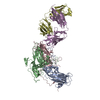
|
|---|---|
| 1 | x 60
|
| 2 |
|
| 3 | x 5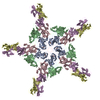
|
| 4 | x 6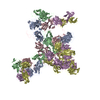
|
| 5 | 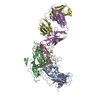
|
| Symmetry | Point symmetry: (Schoenflies symbol: I (icosahedral)) |
- Components
Components
| #1: Protein | Mass: 32787.902 Da / Num. of mol.: 1 Source method: isolated from a genetically manipulated source Source: (gene. exp.)   Enterovirus A71 / Cell line (production host): VERO / Production host: Enterovirus A71 / Cell line (production host): VERO / Production host:  Chlorocebus aethiops (grivet) / References: UniProt: G5CUH3 Chlorocebus aethiops (grivet) / References: UniProt: G5CUH3 |
|---|---|
| #2: Protein | Mass: 26874.252 Da / Num. of mol.: 1 Source method: isolated from a genetically manipulated source Source: (gene. exp.)   Enterovirus A71 / Cell line (production host): VERO / Production host: Enterovirus A71 / Cell line (production host): VERO / Production host:  Chlorocebus aethiops (grivet) / References: UniProt: A0A1P8LK26, UniProt: E0WWC7*PLUS Chlorocebus aethiops (grivet) / References: UniProt: A0A1P8LK26, UniProt: E0WWC7*PLUS |
| #3: Protein | Mass: 26468.225 Da / Num. of mol.: 1 Source method: isolated from a genetically manipulated source Source: (gene. exp.)   Enterovirus A71 / Cell line (production host): VERO / Production host: Enterovirus A71 / Cell line (production host): VERO / Production host:  Chlorocebus aethiops (grivet) / References: UniProt: W8XVT2 Chlorocebus aethiops (grivet) / References: UniProt: W8XVT2 |
| #4: Antibody | Mass: 23283.535 Da / Num. of mol.: 1 Source method: isolated from a genetically manipulated source Source: (gene. exp.)   |
| #5: Antibody | Mass: 23671.650 Da / Num. of mol.: 1 Source method: isolated from a genetically manipulated source Source: (gene. exp.)   |
-Experimental details
-Experiment
| Experiment | Method: ELECTRON MICROSCOPY |
|---|---|
| EM experiment | Aggregation state: PARTICLE / 3D reconstruction method: single particle reconstruction |
- Sample preparation
Sample preparation
| Component |
| ||||||||||||||||||||||||
|---|---|---|---|---|---|---|---|---|---|---|---|---|---|---|---|---|---|---|---|---|---|---|---|---|---|
| Source (natural) |
| ||||||||||||||||||||||||
| Source (recombinant) |
| ||||||||||||||||||||||||
| Buffer solution | pH: 7.4 | ||||||||||||||||||||||||
| Specimen | Embedding applied: NO / Shadowing applied: NO / Staining applied: NO / Vitrification applied: YES | ||||||||||||||||||||||||
| Vitrification | Cryogen name: ETHANE |
- Electron microscopy imaging
Electron microscopy imaging
| Experimental equipment |  Model: Tecnai Polara / Image courtesy: FEI Company |
|---|---|
| Microscopy | Model: FEI POLARA 300 |
| Electron gun | Electron source:  FIELD EMISSION GUN / Accelerating voltage: 300 kV / Illumination mode: FLOOD BEAM FIELD EMISSION GUN / Accelerating voltage: 300 kV / Illumination mode: FLOOD BEAM |
| Electron lens | Mode: BRIGHT FIELD |
| Image recording | Electron dose: 20 e/Å2 / Film or detector model: GATAN K2 SUMMIT (4k x 4k) |
- Processing
Processing
| CTF correction | Type: NONE |
|---|---|
| 3D reconstruction | Resolution: 6.8 Å / Resolution method: FSC 0.143 CUT-OFF / Num. of particles: 1100 / Symmetry type: POINT |
 Movie
Movie Controller
Controller




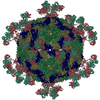


 PDBj
PDBj



